

Headline Sponsors:
Organised by:
Supported by:

Presented by:



Headline Sponsors:
Organised by:
Supported by:

Presented by:
Mobility hubs are spaces where public, shared and active travel modes are co-located alongside improvements to the public realm. They enable travellers to make smooth and safe transfers between different modes, swapping private cars for shared vehicles, bikes, buses, trains, scooters or walking.
When reimagined as mobility hubs, car parks and park & ride sites are no longer just somewhere to store vehicles. Instead they become genuine interchanges. Meanwhile, the provision electric vehicle (EV) charging points at mobility hubs supports the transition to zeroemission vehicles.
The emergence of service hubs is also seeing car parks being transformed into logistics bases for last-mile delivery services, click & collect locations and homes to dark kitchens and dark stores.
The second annual Mobility Hubs conference sees speakers and expert panels explore the design, implementation and operation of mobility, EV and service hubs. The day will draw on real world experience and showcase best practice from around the UK and internationally.
Speakers include:
l Olga Anapryenka, principal consultant, new mobility, Steer
l John Austin, researcher and working partner, University of Plymouth
l Trevor Brennan, project lead, England’s Economic Heartland
l Kris Beuret, director, Social Research Associates
l John Dales, director, Urban Movement
l Matt Griffiths-Rimmer, director of communications and partnerships, Hadley Property Group

l Dan Gullock, architect, director, Fatkin
l Kate Jack, sector lead for smart mobility, Stantec
l Mar us Lauble, managing director, HUBER Car Park Systems


l Matthew Ledbury, senior policy and advocacy officer, CoMoUK
l Simon Lusby, technical director, head of transport & sustainability, City Science
l Habib Khan, founder & director, Meristem Design

l David Knight, director, transport planning, Norman Rourke Pryme
l Julian Scriven, managing director, Brompton Bike Hire

l Mark Selby, director, Project Beyond Consortium
l Grace Solsby, principal consultant, City Science

Exhibitors include:
The event’s exhibition provides an excellent opportunity to showcase your systems and services. To find out how your organisation can be part of the day contact Jason Conboy on: jason.conboy@landor.co.uk

Editorial Managing editor:
Mark Moran Tel: 020 7091 7871 mark.moran@landor.co.uk
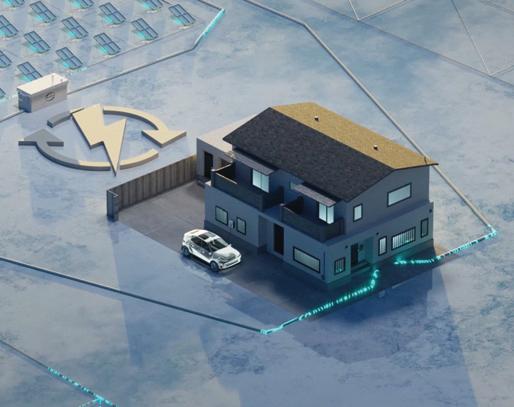
Production and design production@landor.co.uk
Advertising, sponsorship, marketing and exhibition packages
Jason Conboy Tel: 020 7091 7895 jason@landor.co.uk


Subscriptions
Christina Pierre Tel: 020 7091 7959 subs@landor.co.uk
Accounts
Irina Cocks Tel: 020 7091 7854 irina.cocks@landor.co.uk
Business manager Rod Fletcher Tel: 0191 280

“Nothing ages so quickly as yesterday’s vision of the future!” said the American film critic Richard Nelson Corliss. Science-fiction movies get many things wrong, especially about how we travel. If we were to believe Blade Runner, Back to the Future and Minority Report, the skies should be full of flying cars and the streets filled with self-driving taxis and hoverboards.
Meanwhile, the car industry has displayed a propensity to get the future even more wrong than the dream factories of Hollywood. Missteps such as atomic cars and the electric Sinclair C5 microcar will be among the ideas on display at the National Motor Museum as part of Motopia? Past Future Visions. The exhibition title is inspired by the British architect Geoffrey Alan Jellicoe who, in the 1950s, described the place where vehicles and humans co-exist in harmony as ‘Motopia’.
Jon Murden, chief executive of the museum, says: “We’ll explore how radical motoring concepts from the past remain relevant today and how these have influenced what we ride and drive, the nature of our towns and cities, the way we work, shop and socialise.”

However, the movies and the carmakers do sometimes get things right. The 1997 thriller Gattaca is set in a future where people drive electric versions of 1960s classics such as the Rover P6 and Citroen DS. The current trend of retrofitting classic vehicles with electric powertrains makes this a pretty good, and a good looking, prediction. Motopia? Past Future Visions is at the National Motor Museum, Beaulieu from 14 April
Mark Moran Editor
Carmakers are as bad at predicting the future as Hollywood... but every so often they get it right
UK new car registrations in March rose by 18.2% to deliver the best ‘new plate month’ performance since before the pandemic, according to the latest figures from the Society of Motor Manufacturers and Traders (SMMT).
The increase saw 287,825 units delivered, the eighth consecutive month of growth for the new car market, as supply chain challenges slowly continue to ease.
As a result, the first quarter of 2023 is the strongest since 2019, with just under half a million new cars joining the road. This represents an additional £2.7bn of deliveries, underlining the contribution the sector can make to UK economic growth, despite the market still being significantly below pre-pandemic levels, down 29.5% on Q1 2019.
Registrations rose across all sales types, with deliveries to
March New Car Registrations 2007-2023
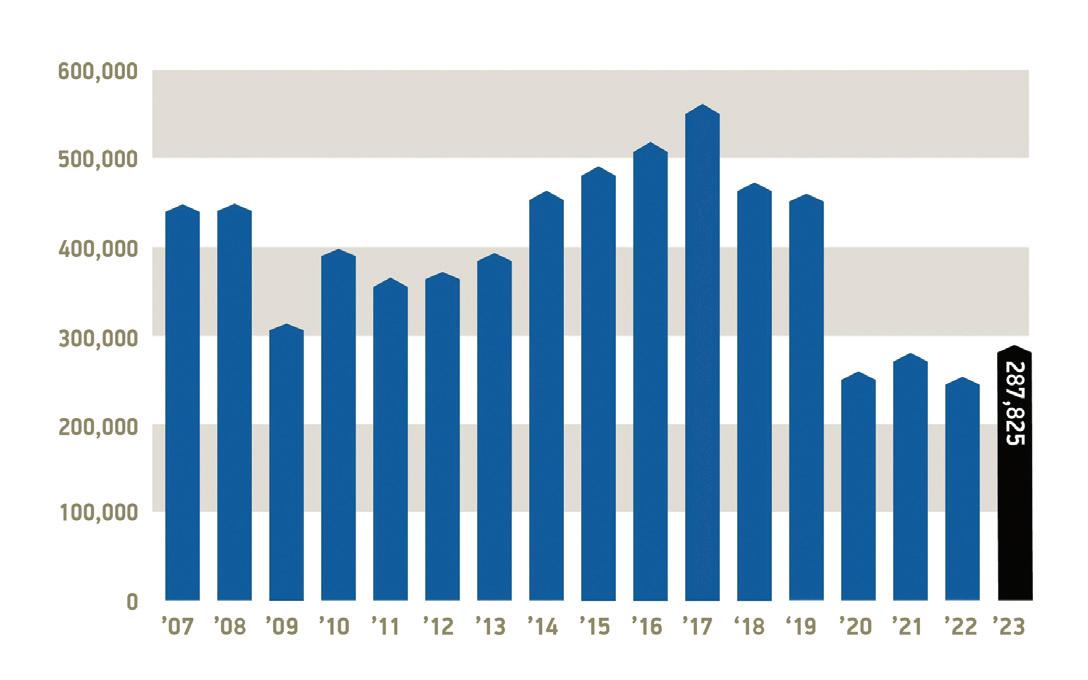
comprised 22.4% of the market – a slight decline on 2022. The biggest growth, however, was in hybrids (HEVs), with a 34.3% surge helping electrified vehicles account for more than one in three registrations for the month.
private buyers up by 1.4%, and those to businesses with fleets of fewer than 25 vehicles up 26.0%. Large fleets, however, were the predominant drivers of March’s growth, with registrations rising by 40,651 units, a 40.9% increase to take an overall 48.6% market share. By segment, superminis posted the largest percentage growth – up 27.2%, to remain Britain’s most popular car type. Lower medium and dual purpose vehicles were the second and third most popular respectively, with all three
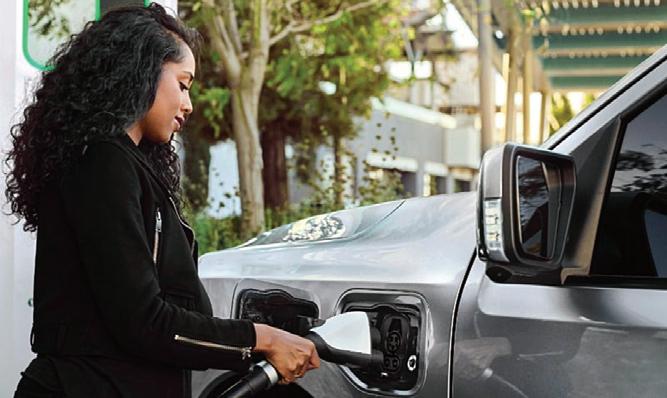
vehicle types combined representing 86.5% of total registrations.
Petrol-powered vehicles remained the most popular fuel type, comprising 56.3% of new units, while battery electric vehicle (BEV) deliveries reached a record monthly high of 46,626, representing growth of 18.6%.
Overall, the BEV market share remained almost the same as last year at 16.2% and, with plug-in hybrid (PHEV) registrations growing by 11.8%, plug-in registrations
Ford says it is on track to achieve carbon neutrality no later than 2050 across its global vehicles, operations and supply chain.
The global carmaker has released Road to Better, its 2023 Integrated Sustainability and Financial Report, which details the company’s progress on creating a more sustainable, inclusive and equitable transportation future.
In Europe, Ford operations, logistics and direct suppliers are aiming to achieve carbon neutrality in 2035, as well as zero tailpipe emissions for all cars and vans.
“We believe the long-term success of any business is inextricably linked with creating value for customers, employees and communities, while also caring for the planet,” said executive chair Bill Ford.
“We are undertaking a massive transformation to lead the electric and connected era of transportation and are committed to being transparent about our progress and opportunities for improvement.”
The new report also highlights progress being made on initiatives aligned with the company’s commitment to source raw materials that are responsibly produced and make its EV and battery supply chain more transparent.
Cynthia Williams, Ford’s global sustainability director, said: “In 2022, we made a number of advancements toward carbon neutrality, including
introducing new exciting EVs, upgrading our facilities, investing in carbon-free and renewable electricity, and using our purchasing power to help scale low-carbon materials. We’re also creating new visibility and accountability for a global EV and battery supply chain that upholds our values.”
Ford of Britain has launched its UK Road to Better website, with France, Germany, Italy, Spain and further markets to follow. These sites will highlight Ford initiatives designed to help build a more sustainable future and will demonstrate progress towards defined sustainability goals.
Ford says it is dedicating more than $50bn from 2022 through 2026 to develop and manufacture electric vehicles and batteries.
The company says it is on the path to reach a
With the publication last week of the consultation on a zero-emission vehicle (ZEV) mandate – due to come into force in less than nine months – the market will have to move more rapidly to battery electric and other zero tailpipe emission cars and vans.
Electric models are coming to market in greater numbers, but the SMMT suggests that consumers will only make the switch if they have the confidence they can charge whenever and wherever they need. Success of the mandate, therefore, will be dependent not just on product availability but on infrastructure providers investing in the public charging network across the UK, said the automotive society.
targeted annual production run rate of 600,000 EVs by late 2023, and more than 2 million by the end of 2026. By 2030, half of Ford’s global vehicle sales volume is expected to be electric.
The report outlines statistics on the impact of this strategy, including the carbon dioxide emissions savings of driving a Ford EV. Estimates show that depending on the model, driving a Ford EV could reduce lifetime carbon dioxide emissions by as much as 60% when charged with US grid-average electricity compared to driving a similar internal combustion engine vehicle. For the Ford F-150 Lightning pick-up, this carbon dioxide reduction over the vehicle’s lifespan is equivalent to the carbon dioxide saved by not using approximately 33,225 litres of petrol.
Beyond reducing tailpipe emissions from its vehicles, the Ford carbon neutrality plan focusses on reducing emissions from the facilities, processes and electricity that support the company’s operations and global supply chain.
Ford claims to have reduced Scopes 1 and 2 emissions by 35.4% since 2017, which accounts for direct emissions from its operations and indirect emissions from energy purchases.
Ford has invested more than $26m in facility upgrades to improve energy efficiency and conservation across its facilities and manufacturing processes, helping the company achieve a 40% reduction in absolute manufacturing greenhouse gas emissions from 2017.

The UK government has launched a package of measures designed to support the decarbonisation of transport as part of a new plan to achieve net zero. Key among them are initiatives designed to support the shift to electric vehicles (EVs): a new investment of £380m in the provision of public chargepoints via the Local Electric Vehicle Infrastructure (LEVI) fund; and the zero-emission Vehicle (ZEV) mandate.
The transition to zero-emission vehicles now forms part of a wider strategy dubbed Powering Up Britain: Energy Security Plan unveiled by the government.
The ZEV mandate and LEVI fund build on progress already made in the transition to electric vehicles, with almost 17% of new cars sold last year being zeroemission.
The EV initiatives support the government’s commitment to end the sale of new petrol and diesel cars and vans by 2030, and from 2035 all new cars and vans must be fully zero-emission at the exhaust. Between 2030 and 2034, all new vehicles must be either fully zero-emission or be able to drive a significant distance with zero emissions.
Transport secretary Mark Harper said:
“Transport is one of the most important sectors for achieving net zero by 2050 and so we must accelerate our efforts to decarbonise how people get from A to B while growing our economy and supporting thousands of green jobs.
“From expanding our charging network to boosting the production of cleaner aviation fuel, today’s announcement is a great stride forwards, offering people more choice on how to stay connected while delivering the carbon reductions needed to achieve net zero.”
The Department for Transport (DfT) has
The government has launched a £381m Local Electric Vehicle Infrastructure (LEVI) fund alongside an additional £15m for the OnStreet Residential Charging Scheme (ORCS). The LEVI Fund gives local authorities across England the opportunity to apply for dedicated electric vehicle (EV) infrastructure and resource funding. The Office for Zero Emission Vehicles (OZEV) and the LEVI Support Body (Energy Saving Trust, Cenex and PA Consulting) are providing ongoing support and guidance to all LEVI funding applicants.
To enable the transition to low carbon transport, ahead of the phase out of new petrol and diesel car sales from 2030, electric vehicle infrastructure needs to keep up with the pace of EVs on the road. Public UK charging devices have more than tripled in four years from 10,300 devices in January 2019 to over 38,700 in March 2023.
The LEVI Fund will give local authorities more power and support to further increase the pace and
scale of rolling out chargepoints across the country, in locations where they are most needed.
The announcement will further accelerate the deployment of local, on-street charging infrastructure across England, especially for those without charging at home:
• £343m capital funding will be made available to local authorities in England, for the installation of EV chargepoints. This includes chargepoint hardware, electrical connection costs, civil engineering costs and other installation costs
• £37.8m capability funding aims to develop in-house expertise within LAs in England, and the ability to coordinate chargepoint plans and work with private operators

• An updated On-Street Residential Chargepoint Scheme (ORCS) remains available to all UK local authorities in 2023/24, with a further £15m available.
LEVI funding is available to eligible county councils, unitary authorities and combined authorities in England.
also unveiled its proposals for a zeroemission vehicle mandate which, from next year, will set minimum annual targets for the percentage of new car and van sales that must be zero-emission.
The DfT said it wants to provide longterm certainty to industry, increasing the number of zero-emission cars available for people to buy and setting a clear direction for operators to accelerate the installation of chargepoints. It proposes that with a greater proportion of zeroemission vehicles on the UK’s roads, more drivers will benefit from lower overall running costs against their petrol and diesel counterparts. This will support a cheaper second-hand EV market while improving air quality across the country.
The final proposals are being jointly consulted upon by the UK government, alongside Scotland, Wales and Northern Ireland, and are the single largest carbon saving measure identified in the government’s Net Zero Strategy.
The government also wants to support the work of manufacturers in the EV sector by giving them flexibility through a credits-based trading system, enabling them to bank credits in years when they exceed annual targets for use in future years or trade them with other manufacturers that have fallen short. If manufacturers do not meet their yearly targets, they could face possible fines of up to £18,000 for every vehicle they miss their target by.
The UK government has reaffirmed its commitment to end the sale of all new petrol and diesel cars and vans by 2030 and for all new cars and vans sold after 2035 to be zeroemission at the tailpipe. It has responded to a technical consultation on the design of a zeroemission vehicle (ZEV) mandate and next steps in the process.
The trajectories proposed in the technical consultation on the mandate have been confirmed. They are that 22% of car production must be EV by 2024, 80% by 2030 and towards 100% by 2035.
The van trajectory is higher than originally suggested with 10% by 2024, 70% in 2030 and, ultimately, 100% by 2035.
The government has effectively ruled out allowing vehicles to be sold to run on ‘expensive’ e-fuels after 2035 with a clear definition that a ZEV “must emit no CO2 or any other targeted greenhouse gases at the exhaust and have a minimum range of at least 120 miles (Worldwide Harmonised Light
The ZEV mandate aims to ensure that vehicle manufacturers have to sell a rising proportion of EVs in the lead up to 2030, beginning in 2024. Through the mandate, manufacturers will have ZEV sales converted into ‘certificates’ and be required to hold a certain number at the end of each year in relation to the total number of vehicles which they have sold. Manufacturers that do not meet their targets will be issued with fines, suggested to be £15,000 per car.
The government says that it will need further consultation on ZEV mandate target trajectories beyond 2030 and to determine a definition for “significant zero-emission capability”, as the two provisions are intrinsically linked. The new consultation will close on 24 May 2023.
The government said earlier that it will continue to regulate the carbon dioxide (CO2) emissions of the nonZEV portion of the fleet to make sure they do not increase.
A plan to help councils, businesses and the freight and servicing industry switch to cargo bikes and e-cargo bikes for deliveries has been unveiled by London’s walking and cycling commissioner Will Norman. The plan was launched at the National Cargo Bike Summit in central London, organised by Landor LINKS and hosted by the City of London Corporation.
“Cargo bikes are no longer a niche concept, and they can be real game changers when it comes to delivering freight and servicing trips,” Norman said. “Not only do they provide environmental benefits by not contributing to air pollution, they also make journeys more efficient, and present a much lower risk of danger to people walking and cycling than vans and HGVs.”
By 2030 cargo bikes could replace up to 4% of van kilometres across Greater London, and as much as 17% of van kilometres in central London, Transport for London (TfL) estimates. It calculates that the carbon savings resulting from cargo bike growth across Greater London will be up to 30,000 tonnes of CO2 a year by 2030.
In London, 90% of all goods are transported by road while around half of the value of household expenditure in London relies on freight, said TfL. Road
freight is a major source of nitrogen dioxide emissions, a key contributor to London’s toxic air, it points out, adding that cargo bikes offer a “much cleaner way to deliver freight and services and deliver considerable air pollution savings, contributing to healthier and safer streets and enabling better use of urban space”.

The use of cargo bikes for freight and servicing trips is becoming more widespread, with businesses including Amazon and DHL, according to TfL.
Cargo bikes also present a lower risk to people walking and cycling than vans and heavy goods vehicles (HGVs), helping to make London’s streets safer and more

The British Vehicle Rental and Leasing Association (BVRLA) has discovered that 40% of local authorities in the UK are yet to engage with the fleet sector when considering electric vehicle charging needs. The results form part of the association’s new Fleet Friendly Charging Index, which also shows that nearly two-thirds (63%) of authorities are yet to publish an EV strategy.
The BVRLA Fleet Friendly Charging Index highlights the scale of the challenge for fleets, who regularly battle with unreliable, inaccessible, or absent public charging infrastructure.
The index and guide are designed to provide insights on the range of charging challenges that fleets are experiencing and highlight some ways in which local and national government, airports and electricity network operators (DNOs) can improve things.
Gerry Keaney, BVRLA chief executive, said: “The fleet sector is pulling the nation forward on its drive to decarbonise, but charging infrastructure is failing to keep up. Local authorities have the power
to make a real difference and we want to help them help fleets.
“Armed with our Fleet Charging Guide, we are supercharging our engagement on this topic. Conversations are taking place with decision
attractive for people using public transport, walking and cycling, says TfL. Christina Calderato, TfL’s director of strategy and policy, said: “Freight and servicing are the lifeblood of London’s economy but also contribute to air pollution, carbon emissions and traffic congestion. We are determined to provide a green, healthy and sustainable future for all Londoners and cargo bikes can play a vital role in cutting carbon emissions, air pollution and road danger. We will continue to work closely with our industry partners, businesses and boroughs across the capital to make our vision for cleaner and safer freight a reality.”
makers the length and breadth of the country. The index shows where the most collaboration is needed, and we are fully equipped to share the insights that will shape a fleet friendly network from Land’s End to John o’ Groats.”
The index was launched alongside an updated Fleet Charging Guide at a reception in the House of Commons on 15 March.
The launch event saw the association and senior industry stakeholders meet with 80 MPs from all parties. The politicians heard about the vital role that fleets play in bringing electric vehicles to UK roads, as well the extreme barriers presented by the current charging infrastructure. The MPs were shown how their constituency ranks at a national level and asked to pledge to support the roll-out of a suitable EV infrastructure.
Transport minister Jesse Norman MP told the gathering: “In this market and in its wider supply chains, the BVRLA and its members are, from a government standpoint, a critical partner in the transition that we’re making to zero-emission vehicles. What we’ve seen today from all of the people taking part here is the importance of collaboration, and developing the two parallel tracks of more vehicle use and better infrastructure. That’s what we’re committed to within government.”
and that this review should also consider how hotels and visitor attractions could be encouraged to have charging points.
The Welsh Government’s current strategy for getting more electric vehicles on the road is inadequate, according to a Senedd committee. The Welsh parliament’s Climate Change, Environment and Infrastructure Committee’s latest report analyses the Welsh Government’s commitments as laid up in a 2021 action plan and found multiple failures to follow through on promises to improve charging facilities made less than 18 months ago.
In its report on implementation of the plan, the Climate Change, Environment, and Infrastructure Committee identifies a lack of action on many of the targets set in the strategy. The committee calls for renewed efforts to achieve Wales’ climate targets and create a greener Wales.
The cross-party review has called on the Welsh Government to complete a review as soon as possible and consider how hotels and visitor attractions could be encouraged to have charging points installed.
The Welsh Government EV Charging Strategy was published in 2021 alongside an action plan. Of the nine main commitments made in the document, the cross-party committee found that five of them had not been delivered on time.

In several cases, the Welsh Government indicated it was only just starting to consider whether or how to proceed with certain actions; months after the deadline for them to be completed.
The committee states that the lack of progress undermines the credibility of the action plan and calls into question the Welsh Government’s commitment and ability to follow through on its commitments. In rural areas, the lack of electricity grid capacity is a significant issue to developing more charging points. This has led to long delays in connecting chargers and an uneven distribution of them across Wales, reports the committee.
The action plan also commits the Welsh Government to establishing a “Connections Group” to co-ordinate the development of this infrastructure across Wales, but the group has never been established. A similar problem issue was found in the Welsh Government’s commitment to determine the best locations for charging points across the
country. The action plan proposed setting up a group to bring together private, public, not-for-profit and community organisations, but this has also never been created.

The committee is calling for both groups to be formed in the next few weeks as a matter of urgency. The Senedd members’ report states that the 2,400 chargers in Wales (out of 37,000 across the UK) is the lowest number of public charging devices and rapid/ultra-rapid devices per 100k population in Great Britain.
Despite a large growth in the number of chargers over the last few years, in Wales there is currently just one rapid charger per 15,000 people compared to one per 11,000 people at UK level.
Despite the Welsh Government promising to review building regulations in 2022 to improve the situation, the committee found that this had also not been delivered. EVA Cymru told the committee that regulations in Wales currently lag behind both Scotland and England in terms of requiring charging points in both domestic and commercial properties. It stated: “In Scotland, a standard (7kW) chargepoint must be provided for each residential building with at least one parking space and a ratio of 1:10 for every non-residential building. England has in place similar requirements and these regulations also extend to substantial renovations.”
The committee’s report calls on the Welsh Government to complete a review of building regulations as soon as possible
Llyr Gruffydd MS, chair of the committee, said: “Moving to a greener Wales means more of us switching from petrol or diesel vehicles to electric models. But people will only want to do this if the charging infrastructure in Wales is good enough, and that we’re confident that we could charge our cars when we need to. Frustratingly, this is far from the case today. There has been some progress over the last few years but nowhere near where it needs to be. The Welsh Government’s action plan isn’t even 18 months old yet and some of the targets have already been missed. This is unacceptable and embarrassing.
“When that plan was written, it described a Wales with the lowest electric vehicle uptake and the lowest number of chargepoints in Great Britain, and there’s nothing we’ve seen since then that would have changed that depressing fact. On several issues, it seems more apt to call it an ‘inaction plan’. The Welsh Government declared a climate emergency only a few years ago yet their progress on this crucial issue is already inadequate. The Welsh Government needs to step it up a gear and follow the committee’s recommendations if they’re serious about reducing the nation’s carbon emissions and getting more of us into electric vehicles.”
The Welsh Government responded by stating that Wales had seen the biggest growth in charger and rapid charger provision across the UK. A Welsh government spokesman said: “We welcome today’s report which contains some key learnings for us as we work to deliver the charging infrastructure Wales needs. We were pleased to see that Wales is now showing the greatest percentage increase of any UK region in charging and rapid charging provision. This is thanks to an ambitious delivery programme we have developed with key partners and we now look forward to building on these foundations.”
Speaking on BBC Radio Wales, deputy minister for climate change Lee Waters said: “We’ve got a plan and we are working through it. We’ve got limited resources and rather than just spraying charging points everywhere we are working out where are the best places to put our resource to best effect. I have an electric car and as long as you plan it’s fine. You will not regret buying one and once you have bought one you won’t go back.”
Senedd climate change committee calls lack of progress ‘embarrassing’senedd.wales Welsh Parliament Climate Change, Environment, and Infrastructure Committee

If an electric vehicle charges while driving, the size of the battery can be reduced by up to 70%, and the load on the power grid can be spread out over the day. Charging on the move suits most people, but not everyone. This is shown by a new study from Chalmers University of Technology in Sweden, where for the first time researchers combine the so-called electric road system with real-life driving patterns of Swedish drivers.
The Swedish government has proposed a ban on new petrol and diesel cars from 2030 to reduce carbon dioxide emissions. The same trends are seen across Europe, as demonstrated by the rapidly increasing sales of electric vehicles. As this development progresses, challenges are also increasing, including the uneven load on the power grid and where to charge the electric vehicles.
When vehicles can be charged dynamically while driving, the battery size can be reduced and still meet all travel demands. This results in lower environmental impact and costs, according to new research from Chalmers. In Sweden, the first electric road will be a 21-kilometre stretch between Örebro and Hallsberg.
The Swedish Transport Administration is leading the project and the road is expected to be completed by 2026. It has not yet been decided which type of charging technology will be used.
Several countries, including Sweden, Denmark, and Germany, are testing whether electric road system (ERS) can be used to electrify road networks. An ERS charges moving vehicles with either loops in or next to the road, or with wires suspended above vehicles, similar to trams and trains. All variants mean that vehicles do not need to be parked to charge, and there is less need for large batteries storing energy to overcome “range anxiety”, a term referring to the fear or concern an electric vehicle driver experiences about the distance their electric vehicle can travel before the battery needs to be charged.
Now researchers from Chalmers have used data from over 400 passenger cars to study real driving patterns on different parts of Swedish national and European roads. They have used the data to calculate, among other things, battery size
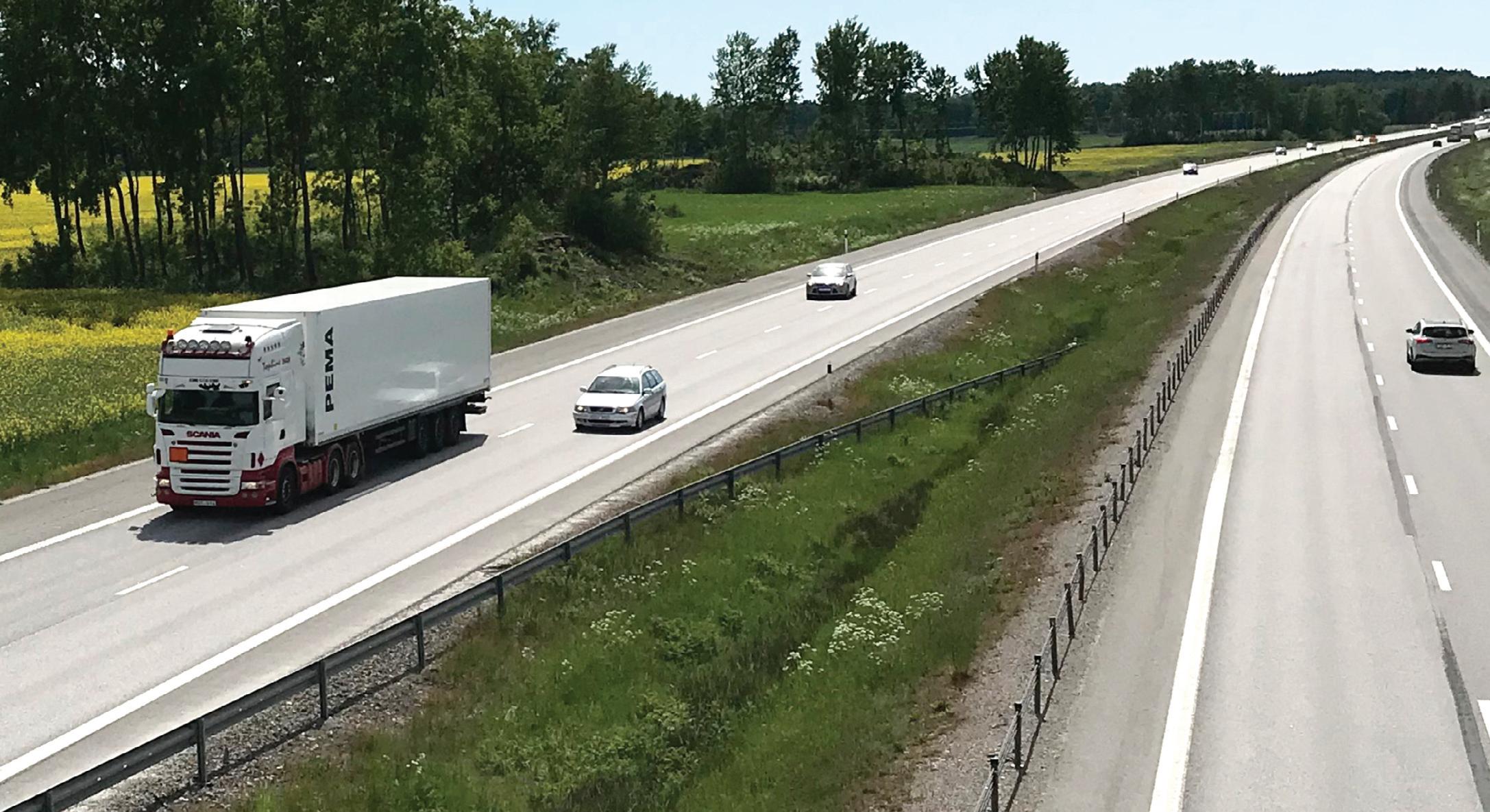
needs to complete all journeys given possible charging options (stationary versus ERS), charging patterns, and total costs including infrastructure and batteries.
The results show that a combination of electric roads on 25% of the busiest national and European roads and home charging would be optimal. The batteries, which account for a large part of the cost for an electric car, can become significantly smaller, at best only one-third of the current size.
“We see that it is possible to reduce the required range of batteries by more than two thirds if you combine charging in this way. This would reduce the need for raw materials for batteries, and an electric car could also become cheaper for the consumer,” said Sten Karlsson, who, together with research colleagues Wasim Shoman and Sonia Yeh, is behind the Benefits of an Electric Road System for Battery Electric Vehicles study.
Other positive effects are that peaks in electricity consumption would be reduced if car drivers did not entirely rely on home charging but also supplemented it with
electric road charging? Karlsson said: “After all, many people charge their cars after work and during the night, which puts a lot of strain on the power grid. By instead charging more evenly throughout the day, peak load would be significantly reduced.”
But different groups of motorists also have different conditions for benefiting from the combination of stationary charging and ERS.
“There are big differences between groups, depending on driving patterns and proximity to electric roads. Even in the optimal case, some would manage with only electric road charging, while others would not be able to use the opportunity at all. For example, we see that those who live in the countryside would need almost 20% greater range on their batteries compared to those who live in a city centre,” says study team member Wasim Shoman. The study also shows that small batteries do not automatically lead to charging through ERS.
Karlsson concludes: “Just because you can charge does not mean the consumer actually wants to do it at every given opportunity. The business model, therefore, becomes extremely important because benefits and costs may become unevenly distributed. And there are no decisions yet on what the business model should look like.”
The Benefits of an Electric Road System for Battery Electric Vehicles study has been funded by Mistra and the Energy Area of Advance at Chalmers University of Technology in Sweden.
The aim of the project was to study what potential benefits there might be with a so-called electric road system (ERS) where cars charge while driving.
While ERS is mainly being considered for trucks to allow them to travel longer distances with smaller batteries, and to avoid waiting for charging, private cars can also benefit. This was the first study to simulate battery charging by studying in detail the movement patterns of 412 privately driven cars on parts of Swedish national and European roads.
Based on the data, the researchers calculated, battery requirements, charging patterns and total costs. The researchers compared three charging scenarios, one with both stationary charging and ERS, one with stationary charging only and one with exclusively ERS charging infrastructure. Trucks or buses are not included in the analysis, so any benefits for these will be added.
A combination of ERS and home charging is optimal and reduces battery demand by 62–71% in the best case scenario. The net savings for the car owner from smaller batteries exceed the cost of ERS. The median battery range required by residents of sparsely populated areas is 15–18% greater than that of urban residents.
Using ERS could also reduce peak charging by spreading charging throughout the day.
Half of UK drivers would buy an electric vehicle if they could use it to power their home, a survey by Indra suggests Drivers growing awareness of the cost of charging up electric vehicles is making the case for vehicleto-everything (V2X) systems, suggests Indra, an EV charging and smart energy technology business that is developing bidirectional charging technologies.
Almost 50% of UK drivers would buy an electric vehicle if they could use it to power their home, suggests a new survey. More than half of UK drivers over-estimate cost of charging an electric vehicle (EV), with 77% wanting more control over their home energy bills.
Indra has conducted a national survey into the latest attitudes and opinions of UK drivers towards electric vehicles, EV charging and electrification. Key findings from the Indra-dex survey suggest that perceived running and purchase costs are putting the brakes on greater EV adoption, meaning thousands of drivers could be missing out on significant cost savings and environmental benefits from switching their petrol and diesel vehicles for electric models.
The survey of over 2,000 UK drivers reveals that despite almost half (47%) worrying about the environmental impact of driving a petrol or diesel vehicle, costs remain the largest barrier to purchasing an EV, with only 30% of respondents likely to buy an electric car in the next 12 months. Some 50% cited price as the biggest barrier, although less than a third (30%) said they were concerned with the lack of public charging points.
The survey also revealed that many drivers believe petrol cars are the most cost-effective mode of transport over the next 6-12 months (37%), followed by public transport (18%) and diesel engine vehicles (18%). EVs came fourth place, with only 16% of those polled believing them to be the cheapest way to travel.
The research also revealed that over 59% of those surveyed over-estimated the cost for charging an EV, with some believing it could amount to £150-£200 for a single charge. These perceptions are contrary to real-world findings, where EV running costs are generally much lower than those of petrol and diesel cars, especially when charged at home.
For example, the average cost of fuelling a petrol 1.5 litre vehicle is £74 for a full tank, equating to approximately 16p per mile. This compares to the
average costs to charge a family-sized EV with a 64kWh battery from empty, estimated to be around £21 when using a standard charger on a standard variable energy tariff.
With the advent of EV-specific tariffs, such as OVO’s Charge Anytime tariff at 10p per kWh accessed using a smart home charger such as the Indra Smart PRO, this could drop to below £7 for a full charge, equating to 2p a mile. This means that drivers of petrol vehicles are paying up to eighttimes more per mile to run their vehicle compared to an EV equivalent.
Mike Schooling, founder and chief product officer at Indra, sees this as just the tip of the iceberg when it comes to cost savings from EVs. “It is already significantly cheaper to run an EV compared to a petrol or diesel vehicle, and this will only improve as we move towards widespread adoption of bidirectional or V2X charging,” said Schooling.
“Bidirectional charging technology takes savings on transport costs to whole new level, enabling EV drivers to not only capitalise on cheaper energy tariffs and lower-carbon energy, but also discharge surplus energy from their vehicles to either power their homes or even trade it back to the grid at peak energy times, when prices are typically at their highest.
“With 61% of drivers admitting they feel they have no control over their home energy bills and 65% believing that turning off appliances is the only way to reduce them, it’s not hard to see how almost half (49%) said bidirectional charging would tempt them to buy an EV.”
Indra developed a bidirectional charger as part of a large-scale trial known as Project Sciurus. The company says trialists of this technology have repeatedly achieved savings of around £100-200 on their monthly energy bills.
This technology is not yet available outside of trials, but Indra has been awarded governmentbacked funding from the V2X Innovation Programme to help enable large-scale adoption of this game-changing technology.
“Bidirectional charging will fundamentally change the way we view and interact with energy and our cars and vans. EVs will effectively become mobile batteries on wheels for harnessing, storing and then using greener, cheaper energy to power our homes or sell back to the grid,” added Mike Schooling.
“In the future, we will no longer be tied to a traditional energy infrastructure, but will be able to access, trade and share energy. This means that EVs and bidirectional charging could play a hugely significant role in creating a flexible, sustainable energy eco-system and enabling the government to achieve its net zero ambitions.”

It is now a year since the government published its response to its 2021 consultation on the consumer experience at public chargepoints. This document presented many sensible proposals essential for mainstream EV adoption, and the government has apparently committed to legislation this year. The consultation offered highly valuable recommendations for EV chargepoint operators, a group that will include both the equipment providers and operators. Its proposals are also relevant to councils and all types of private and public car park operators providing services in the public domain.
Now is a good time to revisit the original report. Whatever the shape of the final legislation, many of the recommendations are in everyone’s interest and should be pushed forward. We will look at a few of them here and discuss what can be done.
One thing is clear in the upcoming legislation, it will require easy ways to pay that don’t rely on apps. In particular, it seems almost certain it will mandate contactless payment at newly installed chargepoints (over 7.4kW), and payment roaming at all public chargepoints by connecting to a thirdparty roaming provider, to enable streamlined payment without the need for numerous apps (the Department for Transport confirmed this in parliamentary questions). This is welcome news. Adding new card readers will be a matter for manufacturers. But to fulfil the spirit of the recommendations, old chargers will also need to be upgraded within a period of 24 months. Ideally, they should be retrofitted, but changing physical infrastructure is difficult and costly and the ramifications on budgets and investment models could be significant.
There is no mention in the proposed legislation of cash payment, and this is something almost no chargepoint provider is doing. Yet cash remains popular among older and lower income drivers when it comes to paying for parking and constitutes a key part of the social inclusion agenda. Cash payments could be done by connecting up chargepoints to existing parking payment terminals (which could also provide an alternative to card retrofitting in some cases).
Finally, existing membership schemes will have to ensure interconnectivity with other schemes –and reciprocal payments to each other – so all charging cards and apps work everywhere.
The key is to offer users choice. The significant supply side issues currently experienced by contactless card terminal manufacturers highlights the need to offer flexible payment options and fall-back solutions and this issue will have to be considered by government when it comes to the legislation.
Users want a simple ‘pump price’ comparable to petrol stations which they can easily compare. This first needs universal charging in kWh to make
data comparable (this is already underway). That will need to be backed by interoperability, standardisation, and data sharing between chargepoints – pumping out pricing data in consistent formats. Such data sharing, which should include any additional fees such as parking, would facilitate behind-the-scenes systems to do standardised calculations, presenting a price to the user, or indeed all the prices in the area for that charge criteria.
In addition to sharing payment data to allow roaming, chargepoint operators should be required to let anyone access their location, usage, and pricing data so that third party apps can be built that allow easy comparison, spurring competition for better user experiences. We hope the new legislation will include provision for this.
Handy helpline facilities at chargepoints do not need to be as clunky as motorway phone boxes. Modern technology offers solutions. While a phone number is one possible option, not all chargers have reception, and some people may not have phones with them. VoIP (Voice over Internet Protocol) technology can be adopted to provide chargepoints with built-in connectivity via a call routing platform, allowing drivers struggling to use the equipment or pay to connect via the internet to a helpdesk operative. That operative will automatically have a direct connection to the chargepoint and payment via the same technology platform, so they can start and end charges and manually process payments if things go wrong.
As we near new legislation aimed at improving the chargepoint experience, it’s clear the future of the EV chargepoint must combine the physical charger with a digital equivalent in the cloud –following the model of digitisation that other industries have taken.
Moving the user experience into the cloud opens channels of communication for operators to share data, integrate multi-party payments, and

open direct channels of communication between operators, customers and third parties. Cloudbased platforms also help gather data and customer feedback for parking operators and government. It also allows operators to easily build added-value services on top, such as loyalty programmes and personalised marketing. As charging becomes open and commoditised, these will allow chargepoint schemes to create differentiated offers to retain customer loyalty, much as supermarkets do.
Digital platforms may not sound very exciting, but in the fragmented world of parking and charging, they are the glue binding together different companies and users. Think of Uber. It does not itself provide a physical service. Rather it offers a cloud platform that connects drivers and passengers. Both share their data while the app handles the locating, communication and payment split. Similar platforms can handle the complex relationships between EV chargepoints, car parks and drivers.
The government’s proposals potentially signal a brighter future as the UK transitions to electric vehicles. We look forward to the legislation. But even now, a user-centric future is coming to charging, and that is good for everyone. It is not too early for operators and local authorities to start embracing the digital technologies that will make these changes possible.
James O’Neill is chief executive of Paythru
Chargepoint providers must embrace digital channels, says James O’Neill
potential obstacles and weight of the charging cable.
Hyundai Motor Group has unveiled an automatic charging robot (ACR) for electric vehicles (EVs). The ACR is a one-arm robot, which communicates with the electric vehicle and is capable of automatically opening the charging port and correctly plugging the charger into the port using control technology applied by a 3D camera-based artificial intelligence algorithm.

Once stationary, the ACR communicates with the vehicle to open the charging port, before calculating the exact location and angle of the charging port through a camera mounted inside. Once charging is completed, it removes the charger and closes the cover of the vehicle’s charging port.
Hyundai expects automatic charging robots to significantly increase convenience of EV charging, and if combined with autonomous parking control systems in future, to improve
utilisation by sequentially charging several parked vehicles.
Dong Jin Hyun, head of Hyundai’s Robotics Lab, said: “The ACR will help to make EV charging easier and more convenient, especially in dark environments. It will also improve accessibility, particularly for people with mobility barriers, as charging cables become thicker and heavier to enable high-speed charging. We will continue developing the ACR for increased safety and more convenience, so that all EV customers can soon benefit
with uneven pavement surfaces, be easy to install and to be safe for all foot traffic. We also offer cashback incentives for customers who share their chargepoint with other members of their community.”
from using it at charging stations.”
The Robotics Lab has considered diverse variables in developing the ACR, such as the parking location of the vehicle, the shape of the charging port, the weather,
In order for a robot to fasten a charger to the charging port securely, software technology that can simultaneously calculate these multiple variables is required. To this end, the group has developed an algorithm that applies 3D camera-based AI technology to robots. The control technology based on this application allows robots to accurately handle heavy chargers.
Given that most EV chargers are installed outdoors without cover, Hyundai’s engineers built a bespoke outdoor electric vehicle charging station at the group’s R&D centre and evaluated performance in various conditions. As a result, the ACR has secured a waterproof and dustproof grade of IP651, and its performance has been improved so that it can be stably operated even in extreme environments.
In addition, engineers have installed a safety pole with a built-in laser sensor around the robot to prevent possible accidents by enabling it to detect stationary and moving obstacles.
Kerbo Charge has developed a selfclosing cable channel for electric car owners
The start-up company says there is a need for such products since 40% of the UK population do not have access to a driveway, meaning a current reliance on the public charging network.
Kerbo Charge co-founder Michael Goulden said: “We developed this product in partnership with local authorities – the critical design requirements are the ability to flex
The Kerbo Charge polymer channel includes a self-closing lid that snaps down shut as the cable is inserted and removed, eliminating the trip hazard. It has been built to contour with the surface of the pavement so will sit flush and its shallow form factor allows for fast installation.

Milton Keynes will be the first city to receive public installations of the new product.
Cllr Jennifer Wilson-Marklew, cabinet member for climate action and sustainability, said: “This is a really innovative and exciting trial which could encourage people to make the switch to electric. We’re constantly looking for ways to both improve charging facilities and to give people the confidence that they will be able to charge their cars.”
Engineering firm EV Civils has announced the launch of its new sister company, EZ Block.
The new company produces a concrete block that aims to speedup electric vehicle chargepoint installations while maintaining a sustainable solution for the long term.

The blocks are designed to provide a secure foundation for charging stations and a uniform finish on a
site regardless of the installer.
EZ Block director Craig Hibbert said: “As electric vehicles become more common, it’s important to ensure that the processes of installing charging stations also remain as sustainable as possible.
“Our new base provides a simple, yet effective solution that allows for quick installs no matter the weather with one of our key aims to facilitate same day installs.”
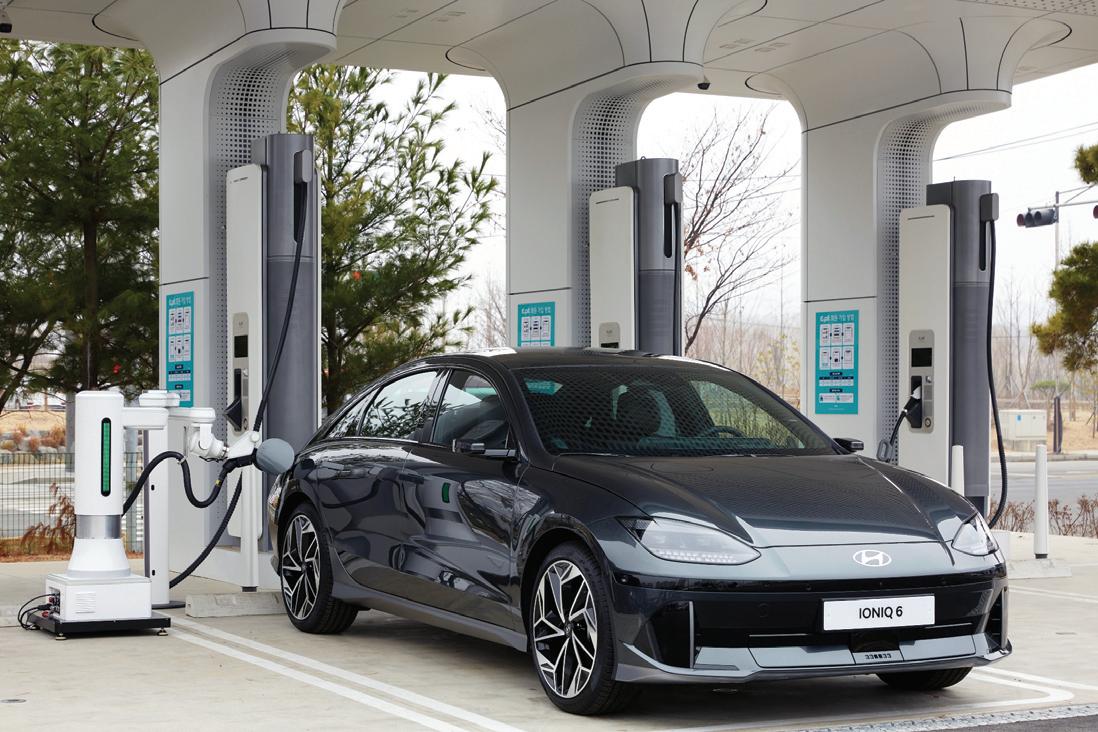
AI driven robot will help people with mobility needsHyundai’s ACR charging an Ioniq 6 The Kerbo Charge cable gulley EZ Block

The voyage starts at 17:45 at Westminster Pier
We will be celebrating the launch of the British Parking Awards 2023 with an evening of amazing sights, entertainment and great food with friends and colleagues from across the parking sector. Book your ticket at: www.transportxtra.com/events

Gold sponsor:Silver sponsors:


